MARKET OVERVIEW
The Global Digital Enhanced Cordless Telecommunications (DECT) market stands as a specialized segment of the telecommunications industry, focusing on cordless voice and data communication solutions. This market converges on DECT, with a technology standard that emerged in Europe and provided high-quality, secure wireless communication solutions over short distances. The Global Digital Enhanced Cordless Telecommunications (DECT) market will gradually attain significance within various sectors, with increasing emphasis on reliable wireless communications for enterprises and households, less the burdensome configuration of cellular networks.
DECT technology catalyzes various applications ranging from cordless communication to wireless data systems and industrial automation solutions. The Global Digital Enhanced Cordless Telecommunications (DECT) market will be influenced by its ability to satisfy specialized communication needs that require low interference, secure transmission, and good voice clarity. Specifically, DECT provides a dedicated frequency band to cellular calls, one that is bound to see less and less serious disruption- a factor that corporations and households will place increased importance upon as wireless environments become congested.
Evolution into more advanced versions will likewise be a defining characteristic of the Global Digital Enhanced Cordless Telecommunications (DECT) market: DECT 6.0; DECT ULE (Ultra Low Energy). This advancement will also lead to applications beyond traditional voice communications, including smart home systems and security monitoring, as well as M2M (machine-to-machine) communication. As the number of applications connected together increases, a growing number of specialists in the domain will find DECT technology a noble alternative for interconnectivity compared to Wi-Fi and Bluetooth, especially regarding battery life, reliability, and range in coverage.
Global Digital Enhanced Cordless Telecommunications (DECT) market trends will also be reinforced by needs coming from the business arena. DECT handsets and systems will be selected in environments such as hospitals, warehouses, hotels, and large corporate campuses due to their solid security features and dedicated communication channels. More and more, these are systems that work outside public cellular networks, quite appealing to organizations worried about data privacy and the reliability of a system. Therefore, DECT solutions will maintain their relevance to the business in the age of advanced mobile and wireless technologies.
Regional dynamics will further mark the scope of the Global Digital Enhanced Cordless Telecommunications (DECT) market. The first major adoption of DECT technology took place in Europe, but other markets, including North America and Asia-Pacific, are gradually adopting it for various applications in smart infrastructure and secure internal communication systems. Regulatory agencies in different regions will exert indirect influence through allocation and maintenance of clear,
Global Digital Enhanced Cordless Telecommunications (DECT) market is estimated to reach $4,159.37 Million by 2032; growing at a CAGR of 1.9% from 2025 to 2032.
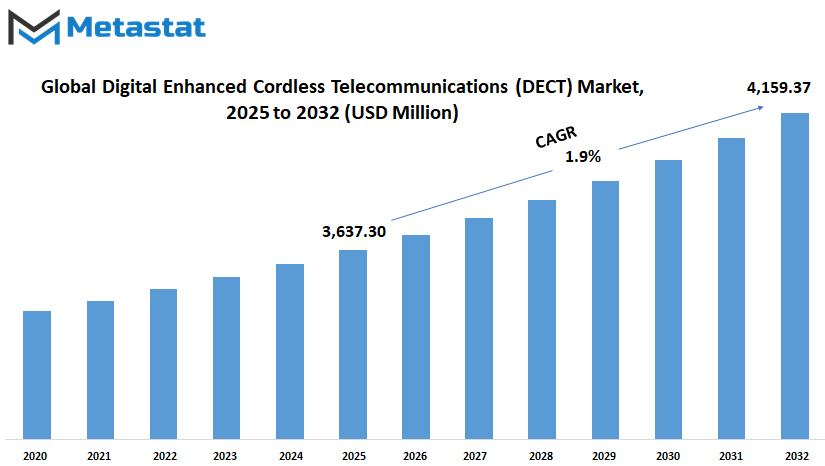
GROWTH FACTORS
The Global Digital Enhanced Cordless Telecommunications (DECT) Market is steadily growing as businesses, and residential consumers are looking for communication solutions that are secure and reliable. Corporate entities are looking for voice communication systems that are free from interference and offer a high degree of security. This need is particularly pressing in situations where confidential conversations are a daily routine. Many places require clear and secure voice connections, from offices to hospitals to customer service centers, where it becomes a necessity rather than a luxury. Therefore, with increased demand, the market is expected to grow steadily.
The rising uptake of cordless telephony products by homes and businesses also acts as a stimulant in this regard. Households prefer cordless phones for the convenience of use, while businesses appreciate how these systems help them keep their internal communications running smoothly while being unencumbered by wires. There is more promise for these cordless systems, and therefore, it is likely that the Global Digital Enhanced Cordless Telecommunications (DECT) market will continue to find many new users and applications in the future.
With all these positive elements in place, the industry could be faced with certain challenges. More and more companies and individuals are fast switching to VoIP and mobile-based alternatives. These present-day alternatives are often cheaper and feature-rich, making them appealing to a wide user base. An additional challenge is that DECT technology has lower data transmission capabilities compared to many modern wireless standards. As needs are growing beyond basic voice communication and into areas that need faster and larger data exchanges, this limitation could potentially inhibit the growth of the market.
In terms of development, prospects for the Global DECT market point toward finding new lanes for growth. The advancement and implementation of DECT-ULE technology seem quite promising. With smart homes gaining ground and more devices coming onto the Internet of Things, the requirement for an energy-efficient, reliable, and secure wireless means of communication shall grow. DECT-ULE could fit snugly in this scenario, providing solutions that might lay the groundwork for it to be a major technology for smart home management and connected-device management. Thus, with these upward trends gaining momentum, there will be new opportunities for the market to flourish and remain relevant in a world that is constantly demanding communication tools of better quality.
MARKET SEGMENTATION
By Type
The Global Digital Enhanced Cordless Telecommunications (DECT) market will continue to move forward with important changes as technology becomes an even bigger part of everyday life. DECT technology, which has long been trusted for providing reliable cordless communication, is now stepping into new areas with fresh possibilities. People often think of DECT only in terms of cordless phones, but its future holds much more. As industries and households keep asking for better, faster, and more energy-efficient communication tools, the Global Digital Enhanced Cordless Telecommunications (DECT) market will likely answer that call with a variety of new solutions.
Looking at how the market is growing by type, DECT Phones are still popular, but they will evolve to offer smarter features. Users are no longer satisfied with just basic call functions. In the coming years, DECT Phones will include smarter interfaces, better integration with digital assistants, and more advanced security settings to protect private conversations. This will make DECT phones not only a choice for homes but also an important tool in professional settings where secure and reliable communication is needed.
Another important part of the future will be DECT ULE, or Ultra-Low Energy devices. As concerns about energy use continue to rise, DECT ULE will stand out as a solution that offers strong communication abilities while using very little power. These devices will be used more and more in smart homes, healthcare, and industries where long battery life is important. Sensors, alarms, and monitors using DECT ULE will make daily life safer and more connected without the worry of constantly charging devices.
At the same time, DECT Wireless Devices will expand what is possible without needing heavy cables or complicated setups. In workplaces, hospitals, and large buildings, DECT Wireless Devices will offer an easy and flexible way to stay connected. Whether it is for voice communication, security systems, or remote monitoring, these devices will fit smoothly into new and existing systems.
Lastly, DECT Infrastructure will play a key role in shaping the future of communication networks. Instead of large and costly systems, there will be more compact, efficient, and easy-to-install DECT Infrastructure options. This will help companies and service providers meet growing demands without overwhelming their budgets.
Overall, the Global Digital Enhanced Cordless Telecommunications (DECT) market will not stay limited to what people are used to today. With new types and new uses, DECT technology will continue to grow in ways that meet both personal and business needs for many years to come.
By Technology
The Global Digital Enhanced Cordless Telecommunications (DECT) market is slowly shaping the way communication devices are used across various industries. Clearly, it is predicted that in the future, many companies will look at DECT technology not just for its basic function of cordless telephony, but for a much wider range of applications including office communication systems, industrial applications, and healthcare. DECT is prized for its ability to offer stable and secure wireless communication, and businesses that cannot afford disruption would gravitate toward it too.
By technology, the Global Digital Enhanced Cordless Telecommunications (DECT) market is divided mainly into Single-Cell DECT and Multi-Cell DECT systems. Single-Cell DECT systems operate mostly in small environments with only basic communication setups. Easy to install and easy to operate, these systems have gained popularity in small enterprises and individual users. With advancing technology and increasing demand, Single-Cell DECT will continue to serve that small-scale operation needing reliable yet simple communication solutions.
As opposed to this, Multi-Cell DECT systems are formed for really very large environments. These systems are created to allow seamless handover between cells, allowing users to walk around large spaces like warehouses, hospitals, or corporate campuses without suspension of connection. In view of the foregoing, in the future, Multi-Cell DECT is likely to perform even better with respect to not just voice communication but also very fast data transfer and integration with smart devices in ever-connected workplaces, where the demand for flexible, scalable DECT systems is bound to shoot higher.
The Global DECT (Digital Enhanced Cordless Telecommunication) market will also tend to integrate more with Internet-based technologies. A stronger focus will be placed on DECT systems being compatible with cloud platforms and cyber security standards. Secure communication channels will have the higher demand ever, and this will push DECT manufacturers to enhance their encryption and authentication schemes as well. Besides, there is the increasing interest applied to DECT systems for applying IoT (Internet of Things) environments, where thousands of devices communicate simultaneously without interference.
Put succinctly, in the future, Single-Cell Systems and Multi-Cell DECT technologies will find uses as long as reliable communications are a necessity. As innovation progresses, the Global Digital Enhanced Cordless Telecommunications (DECT) market will continue to play a significant role in developing smarter and more efficient communication networks worldwide.
By Application
This Digital Enhanced Cordless Telecommunication global market, Digital Enhanced Cordless Telecommunications (DECT), will grow, thrive, and shape communication in the future. As most demands begin to rise, new opportunities will be expected in various applications all over the sectors- DECT technology applications. Originally conceived as a means to voice-cordless applications, DECT has long progressed beyond this initial concept. DECT now offers solutions not just for voice but also data and M2M.
The Global DECT (Digital Enhanced Cordless Telecommunications Market) is mostly classified into voice communication, data communication, and M2M communication in terms of application. One of the primary areas where DECT technology will occupy critical space is voice communication. It not only has clear voice quality and high security but also works without the dependency of any internet, making it quite apt for both businesses and homes. Even as other methods mature, the simple, trusted nature of DECT voice systems will ensure they remain relevant.
Data transfer-information is yet another area in which DECT technology advances forward. As companies and industries rely more and more on smooth operations to maintain that transferred data, DECT also has put itself to use for using wireless access into the networks, transferring files, and facilitating remote work settings. Unlike Wi-Fi, which uses a common frequency, DECT operates on a different frequency range; therefore, it avoids many problems such as interference from signals. This leads to a bright future for DECT where speed, stability, and interference-free security are crucial.
M2M communication will probably be the most interesting future leg of the Global Digital Enhanced Cordless Telecommunications (DECT) market. The smarter technologies penetrate all aspects of daily life-from smart homes to smart foods and automated industries-the more necessity will rise for machines to communicate with one another. With high security and a reliable connection, DECT technology finds itself in a great position to embrace this wave of transformation. DECT-equipped devices for M2M communication will exchange various bits of information with little human involvement, accelerating these processes and making them safer and more productive.
In the direction of the future, the global market for Digital Enhanced Cordless Telecommunications will alleviate today's needs and boost the roll-out of tomorrow's communication networks. Emerging new applications will continue to keep DECT technology relevant and evolving-the test of its value in an increasingly important communication world characterized by its clarity, security, and flexibility.
By End-Users
The Global Digital Enhanced Cordless Telecommunications (DECT) market is molding the future of wireless communications in various ways, some familiar while others entirely new. As more and more people ask for reliable, flexible, and secure means of communication, DECT fits the bill. Voice transmission and security are two qualities for which DECT has been well proved; thus with increasing demand, it will become ever more important. While the new technologies take center stage, quietly beside them DECT is proving its worth and securing a better future. With events to unfold, it will grow in importance as further applications arise to address modern issues.
The Global Digital Enhanced Cordless Telecommunications (DECT) market is therefore segmented according to end-users into residential, commercial, and industrial. All these segments have some requirements for DECT technology, which is flexible enough to cater to them all. In homes, people will continue to seek very simple-to-use cordless phones and communication systems that provide clarity and reliability without complex setup requirements. DECT offers this, and it will continue to grow with advances in battery life, sound quality, and integration of smart home systems. Families will likely enjoy a more connected experience with seamlessly linking devices that provide greater means to offset hacking or interference.
From the commercial world, DECT will remain important for communication between offices, warehouses, and customer service centers. The future will see more portable, lightweight devices that help employees remain connected while at work without having to be tied to their desks. With companies looking for ways to implement more flexible working environments, the demand for DECT systems that guarantee performance over a larger working area will also increase. Security will also be a high consideration since future DECT solutions will offer high encryption to ensure that sensitive information is secure.
On the industrial front, industries such as factories, plants, and logistics centres will require DECT systems capable of withstanding harsh environmental conditions and covering large distances. These developments will probably lead to the production of even more rugged and strong devices, allowing workers to communicate clearly no matter the given conditions. Further, integration with various systems, including alarms and supervisory equipment, will need to be emphasized, thus enhancing DECT technology's role in industrial safety and efficiency.
The Global Digital Enhanced Cordless Telecommunications (DECT) market holds a promising prospect in the years to come. Due to its potential to adapt and improved features, it will remain an active player for the next many years in the residential, commercial, and industrial areas.
|
Forecast Period |
2025-2032 |
|
Market Size in 2025 |
$3,637.30 million |
|
Market Size by 2032 |
$4,159.37 Million |
|
Growth Rate from 2025 to 2032 |
1.9% |
|
Base Year |
2024 |
|
Regions Covered |
North America, Europe, Asia-Pacific, South America, Middle East & Africa |
REGIONAL ANALYSIS
The Digital Enhanced Cordless Telecommunications (DECT) Market is influenced by local continues in each region, facilitating the growth and adoption of the DECT. Each of these locations has its own set of opportunities and obstacles challenging the market dynamics. Understanding these regional differences can also help one to predict the future of the global DECT market as well as changes businesses will make with respect to the strategies they intend to employ.
The North American market is well known for the improvement and innovations in technology and growing requirements for efficient and effective wireless communications techniques. This region also comprises the U.S., Canada, and Mexico; out of which, the U.S. leads in innovation and adoption. Both residential and commercial requirements use high demand to favor the implementation of DECT technology in North America. As more businesses resort to cordless communication systems for increased connectivity and mobility, the future is bright for growth in this area, especially as industries find more efficient means of communicating wirelessly and home users begin to enjoy the convenience and reliability of DECT phones.
This is an important part of the great DECT market for the rest of the globe; having countries like the United Kingdom, Germany, France, and even Italy taking the lead in technological developments and adopting DECT, it is way ahead of other countries like Africa and Asia. Nevertheless, DECT is associated quite well with both personal and business uses putting a lot in improving the user experience through reliable quality systems. Businesses in Europe are particularly keen on adopting DECT into their operations owing to its effectiveness in cost savings and provision of steady wireless coverage. Therefore, such increased digitization and convergence towards integrated solutions in the region will no doubt create quite a higher demand for DECT technology, especially for applications within healthcare, manufacturing, and retail industries, where they require very efficient communication systems.
Another key region regarding the world's DECT market is Asia-Pacific, with some of the leading countries in DECT demand being India, China, Japan, and South Korea. Rapid development in technology coupled with increasing urbanization and a very fast-growing middle class makes Asia-Pacific an important market for DECT solutions. As the new technological revolutions have been taking place such as still running at a fast pace, demand for DECT systems in this region is likely to experience significant growth along with consumers as well as businesses. Adoption of DECT is expected to go well into countries with an upper hand in technology for years, such as Japan and South Korea, due to the demand for clad and high-end communication systems.
In South America, however, the DECT market is predicted to grow steadily, as most businesses and households recognize the advantages of cordless telecommunications. Brazil and Argentina are leading this trend with increasing urbanization and technological advancement.
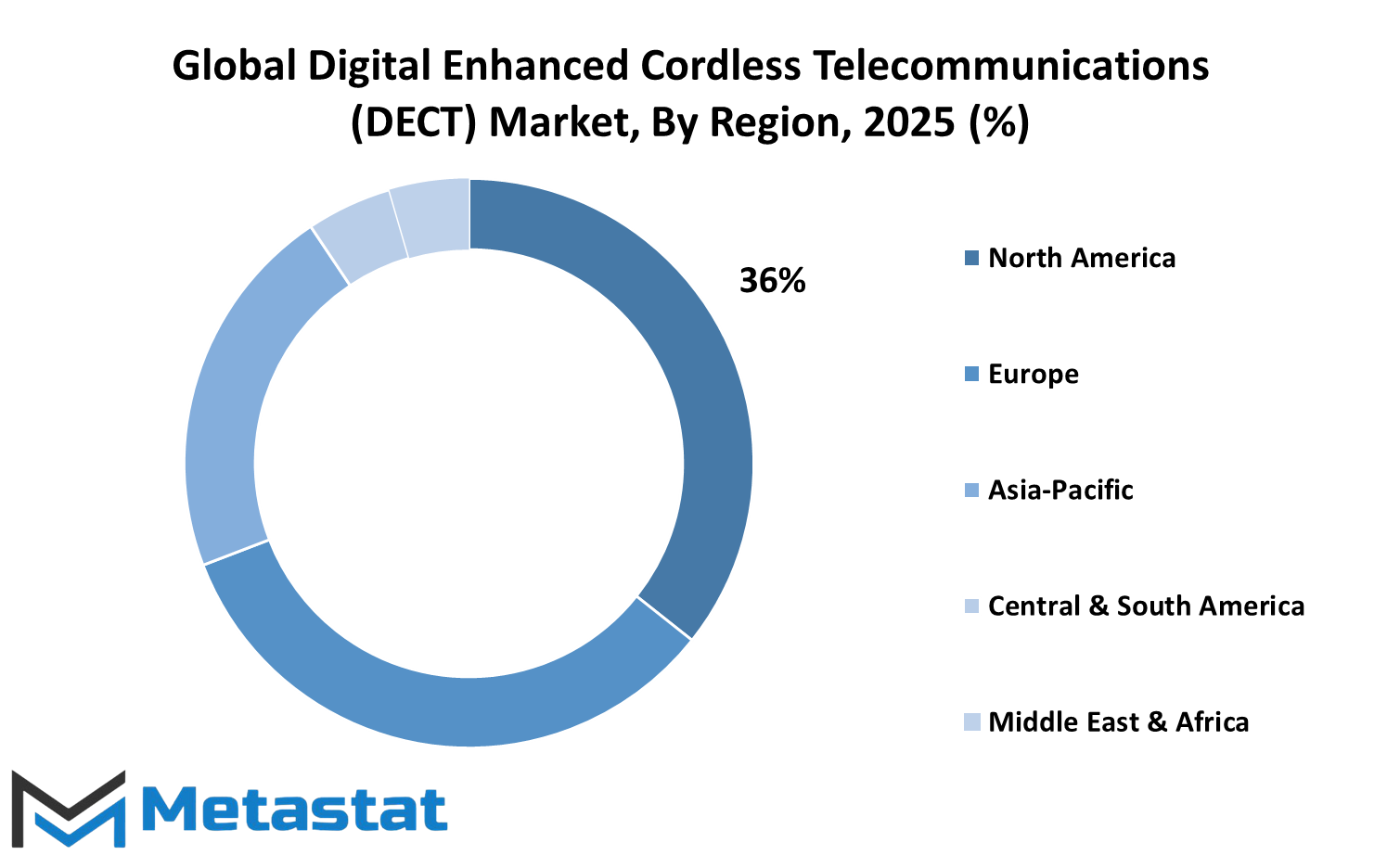
COMPETITIVE PLAYERS
Such technologies will surely keep growing at a steady rate with the increasing global demand for more competent and efficient systems for communication, which can also be cost-effective. Latest inventions in wireless technology and the growing trend of work-from-home businesses or individuals require better cordless communication solutions. In addition to growth in the market, the large industries manufacture various products targeting different needs, be it an individualizable personal home communication system, or an entire organization.
Increased scope in the global DECT market comprises Panasonic Corporation, a well-known leader in the business for high-grade cordless telephony and communications devices. Its strength lies in having a very innovative product combination, catering both to consumer and business markets. VTech Communications, Inc., is equally a prominent player in the DECT global market, typically recognized for its reliable and price-competitive solutions for residential and business use. It sells its wide offerings and winning-fast market share based on site-friendliness in applications and functionality. Long-range DECT facilities that tie it with both homes and offices requiring stable and interference-free communication are also Uniden's forte.
This firm, Yealink Inc., is very much another excellent one in the DECT global market, offering desk phones and wireless handsets and other products to businesses. It provides specific DECT solutions that have become a choice for countries needing top-notch voice communication systems in their working affairs. Another name of significance is Grandstream Networks Inc., which brings to the market within-developing sections world-class innovative communication solutions focusing VoIP technology and wireless communication to enrich business and personal use.
HP Development Company, L.P. (Poly) has one of the world's most diverse portfolios, technologically and in DECT solutions, which have become one of the flexibly scalable and secure systems of integration into enterprises. Mitel Networks Corp. has an excellent reputation in the enterprise communications area built over many years and focuses on providing customized solutions that would enable organizations to improve productivity by enhancing their communication infrastructure.
Of the much smaller companies in the field, Ascom Holding AG and RTX A/S, have made strides in DECT solutions for healthcare and industrial environments. Their products are built for specific communications needs in those areas. In addition, Nokia has a strong presence through its subsidiary, Alcatel-Lucent Enterprise. Innovations in DECT-based communications systems for businesses are also in the range of AT&T Inc. in the long list of these players.
Digital Enhanced Cordless Telecommunications (DECT) Market Key Segments:
By Type
- DECT Phone
- DECT ULE (Ultra-Low Energy)
- DECT Wireless Devices
- DECT Infrastructure
By Technology
- Single-Cell DECT
- Multi-Cell DECT
By Application
- Voice Communication
- Data Communication
- M2M (Machine-to-Machine) Communication
By End-Users
- Residential
- Commercial
- Industrial
Key Global Digital Enhanced Cordless Telecommunications (DECT) Industry Players
- Panasonic Corporation
- VTech Communications, Inc.
- Uniden
- Yealink Inc.
- Grandstream Networks Inc.
- HP Development Company, L.P. (Poly)
- Mitel Networks Corp.
- Ascom Holding AG
- RTX A/S
- Alcatel-Lucent Enterprise
- AT&T Inc.
WHAT REPORT PROVIDES
- Full in-depth analysis of the parent Industry
- Important changes in market and its dynamics
- Segmentation details of the market
- Former, on-going, and projected market analysis in terms of volume and value
- Assessment of niche industry developments
- Market share analysis
- Key strategies of major players
- Emerging segments and regional growth potential



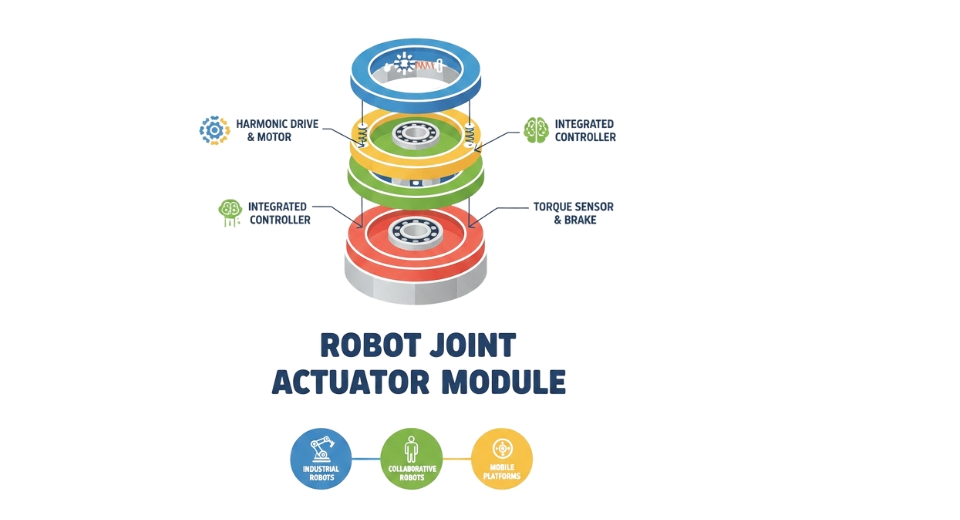
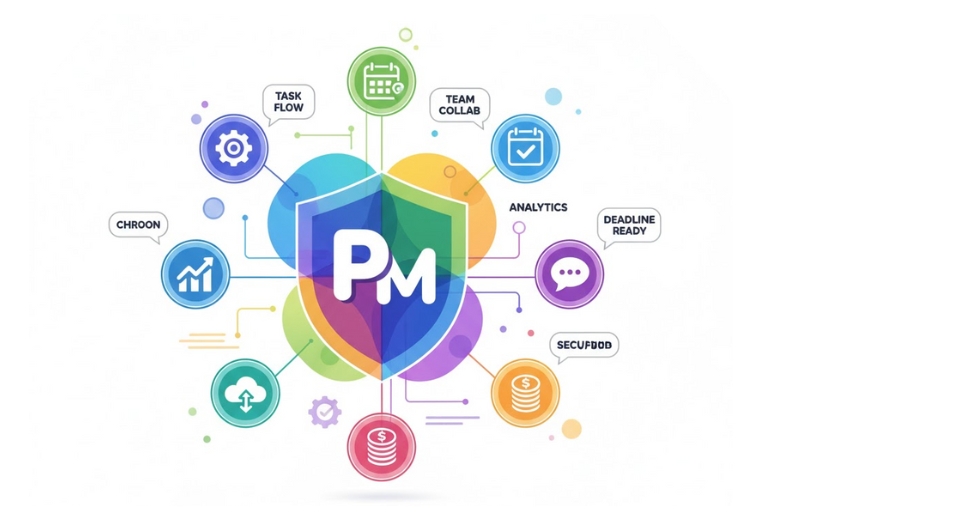
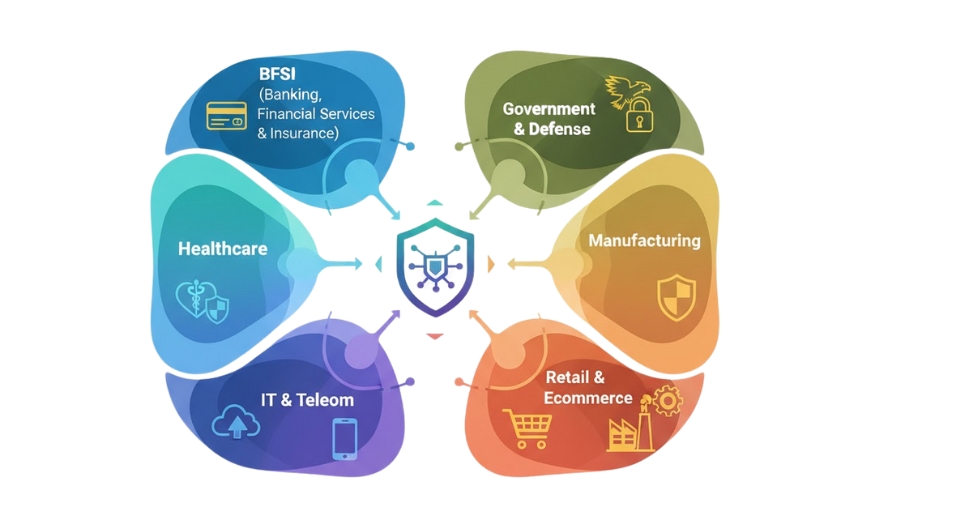


 US: +1 3023308252
US: +1 3023308252






